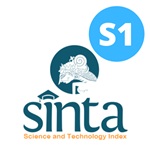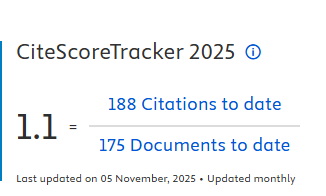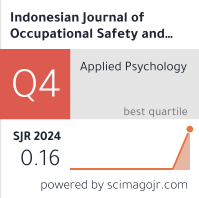Relationship between Motivation, Knowledge, and Availability with the Use of Personal Protective Equipment
Downloads
Introduction: Clinical laboratories are a kind of workplace that must be designed in strict compliance with occupational health and safety standards to create a safe work environment. Fatal work accidents can inflict injuries caused by improper use of equipment, poisoning due to chemical substances in clinical laboratories, and transmission of dangerous diseases. Methods: This is an observational research with a cross sectional approach. The population of this study was 15 health analysts in the X Regional Clinical Laboratory of East Java. The research used total sampling method, carried out from July to September 2018. The dependent variable is the use of PPE and the independent variables are the lack of control and the basic causes. Data were analyzed using Chi square and Spearman correlation tests. Results: 53.3% of the employees of X Regional Clinical Laboratory of East Java use PPE accordingly. There is a strong relationship between knowledge and the use of PPE (r= 0.607). There is a strong correlation between the motivation and the use of PPE (r= 0.600). There is a strong relationship between the availability of PPE and the use of PPE (r = 0.756). Conclusion:There is a strong relationship between knowledge, motivation, and availability of PPE with the use of PPE.
Keywords: knowledge, motivation, personal protective equipment
Alhayati, D. F., Restuastuti, T. and Fatmawati (2014) ‘The Correlation between Clinical Pathology Laboratory Officers' Knowledges and Attitudes in Personal Protective Equipment Utilization in RSUD Arifin Achmad Riau Province', Jurnal Online Mahasiswa (JOM) Fakultas Kedokteran, 1(2), pp. 1–11.
Geller, E. S. (2001) The Pshychology Of Safety Handbook. United State America: Lewis Publishers.
Gunawan, I. and Mudayana, A. A. (2016) ‘Relationship Between Knowledge, Attitudes and Motivation with Behavior of Use of Personal Protective Equipment in Production Workers PT Katingan Indah Kusuma, Kotawaringin Timur Regency, Central Kalimantan Province', Unnes Journal of Public Health, 5(4), pp. 336–347.
Harlan, A. N. and Paskarini, I. (2014) ‘Factors Related to the Behavior of the Use of PPE in Laboratory Workers at PHC Surabaya Hospital', The Indonesian Journal of Occupational Safety, Health and Environment, 1(1), pp. 107–119.
Hayulita, S. and Paija, F. (2014) ‘The Correlation between Clinical Pathology Laboratory Officers' Knowledges and Attitudes in Personal Protective Equipment Utilization in RSUD Arifin Achmad Riau Province', Jurnal Ilmu Kesehatan 'Afiyah, 2(1), pp. 28–35.
International Labour Organization and World Health Organization (2005) Joint ILO / WHO Guidelines on Health Services and HIV / AIDS. Geneva: International Labour Organization and World Health Organization.
Janah, N. (2009) Several Factors Associated with the Use of Personal Protective Equipment at Workers of the Clinical Pathology Laboratory at Sidoarjo Hospital. Undergraduate Thesis. Surabaya: Faculty of Publich Health Universitas Airlangga.
Liambo, I. S. D., Yasnani and Munandar, S. (2017) ‘Factors Associated with the Behavior of Use of Personal Protective Equipment (PPE) in PT PLN (Persero) Technician Area Sulselrabar Generation Sector Kendari Unit PLTD Wua-Wua Kendari City Year 2017', Jurnal Ilmiah Mahasiswa Keseahatan Masyarakat, 2(6), pp. 1–9.
Madyanti, D. R. (2012) Factors that Influence the Use of Personal Protective Equipment (PPE) in Midwives when Performing Labor Assistance in Bengkilis Hospital in 2012. Undergraduate Thesis. Depok: Faculty of Publich Health Universitas Indonesia.
Minister of Health the Republic Indonesia (2010) Number 411/MENKES/PER/ III/2010. Concerning Clinical Laboratories. Jakarta: Ministry of Health the Republic Indonesia.
Minister of Manpower and Transmigration of the Republic of Indonesia (1981) Obligations to Report Diseases Due to Work. Jakarta: Ministry of Manpower and Transmigration of the Republic of Indonesia.
Neal, A. and Griffin, M. A. (2004) ‘Safety Climate and Safety at Work', in Barling, J. and Frone, M. R. (eds) Psychology of Workplace Saftey. Washington, DC: American Phychological Association, pp. 15–34.
Notoatmodjo, S. (2003) Health Education and Behavior. Jakarta: PT. Rineka Cipta.
Notoatmodjo, S. (2012) Health Promotion and Health Behavior. Jakarta: Rineka Cipta.
President of the Republic of Indonesia (1970) Law Number 1 of 1970 about Occupational Safety. Jakarta: President of the Republic of Indonesia.
Rahayu, P. (2011) ‘Factor Analysis of Use of Personal Protection Equipment (PPE) on Officers in the Laboratory Service Unit', Jurnal Kesehatan, 2(2), pp. 371–378.
Ramli, S. (2010) Occupational Health and Safety Management System (OHSAS 18001), K3 Management Series. Jakarta: Dian Rakyat.
Regulation of the Minister of Manpower and Transmigration of the Republic of Indonesia (2010) Number PER.08/MEN/VII/ 2010. Concerning Personal Protective Equipment, Jakarta: Minister of Manpower and Transmigration of the Republic of Indonesia. Jakarta: Ministry of Manpower and Transmigration of the Republic of Indonesia.
Sari, C. R. (2012) Characteristic Relationships Workers with Work Accidents. Undergraduate Thesis. Surabaya: Faculty of Public Health Universitas Airlangga.
Suma'mur, P. K. (1996) Corporate Hygiene and Occupational Health. Jakarta: PT. Toko Gunung Agung.
Wijayanto, W. (2015) Correlation between Nurses' Motivation and Their Attitude in the Use of Personal Protective Equipment at the Time of Chemotherapy Administration at the Inpatient Unit of Dr. Moewardi General Hospital of Surakarta Abstract. Undergraduate Thesis. Surakarta: Bachelor Degree Program in Nursing Science, STIKES Kusuma Husada.

In order to be accepted and published by The Indonesian Journal of Occupational Safety and Health, Author(s) who submit an article should complete all the review process. The copyright of received articles assigned to the The Indonesian Journal of Occupational Safety and Health and Department of Safety and Health, Universitas Airlangga as publishers of the journal. The intended copyright includes the rights to publish articles in various forms (including reprints).
The Editorial Team of The Indonesian Journal Of Occupational Safety and Health and Department of Safety and Health strive to ensure that no errors occur in the articles that have been published, both data errors and statements in the article.
Users of this website will be licensed to use materials from this website following the Creative Commons Attribution-NonCommercial-ShareAlike 4.0 International License. No fees charged. Please use the materials accordingly.
------------------------------------------------------------------------------------------------------------------------------------------------------------------------------------------
Attribution ” You must give appropriate credit, provide a link to the license, and indicate if changes were made. You may do so in any reasonable manner, but not in any way that suggests the licensor endorses you or your use.
NonCommercial ” You may not use the material for commercial purposes.
ShareAlike ” If you remix, transform, or build upon the material, you must distribute your contributions under the same license as the original.







 How to Submit Articles in OJS
How to Submit Articles in OJS

























